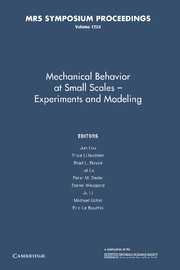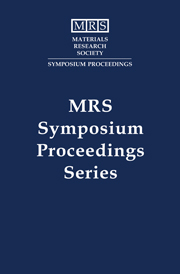Multiscale Phenomena in Materials – Experiments and Modeling Related to Mechanical Behavior
In recent years there has been increasing interest in using what are termed 'multiscale modeling' approaches to understand the effects of composition and microstructure on mechanical behavior of materials. It is of utmost importance that these modeling efforts and simulations at the various length scales be coupled with experimental work. This 2003 volume focuses on experimentally validated multiscale modeling of ductile metals and alloys. The areas of atomistic, mesoscopic and continuum modeling are featured. Topics include: multiscale modeling of plastic deformation; dislocation phenomena at the atomistic-length scale; multiscale modeling of thin films and nanoindentation; multiscale modeling of dislocation phenomena and plastic deformation; multiscale modeling of microstructures and experiments; and models and experiments in nanostructured materials.
Product details
No date availablePaperback
9781107409378
314 pages
229 × 152 × 17 mm
0.42kg
Table of Contents
- Preface
- Materials Research Society symposium proceedings
- Part I. Multiscale Modeling of Plastic Deformation:
- 1. Dislocation patterning and recovery under single slip: modeling micromechanisms from observations
- 2. Dislocation behaviour during deformation - combining experiments, simulation and modeling
- 3. Dislocation intersections and reactions in FCC and BCC crystals
- 4. Single crystal deformation experiments for validation of dislocation dynamics simulations
- Part II. Dislocation Phenomena at the Atomistic Length Scale:
- 5. Structure of dislocation core in GaAs
- Part III. Multiscale Modeling of Thin Films and Nano-Indentation:
- 6. Plasticity-related phenomena in metallic films on substrates
- 7. 3D simulation of the dislocation dynamics in polycrystalline metal thin films
- 8. Parallel glide: a fundamentally different type of dislocation motion in ultrathin metal films
- 9. Metallic island coalescence: molecular dynamics simulations of boundary formation and tensile strain in polycrystalline thin films
- 10. Atomistic and continuum studies of diffusional creep and associated dislocation mechanisms in thin films on substrates
- Part IV. Multiscale Modeling of Dislocation Phenomena and Plastic Deformation:
- 11. On the interaction between Mg solute atoms and dislocations in Al-Mg binary alloys
- 12. Dislocation core structure evolution during dislocation glide in FCC lattices
- 13. Some theoretical aspects of the Grüneisen coefficient for the equation of state of solids
- 14. A combined ab initio and bond-order potentials study of cohesion in iridium
- 15. Statistical dislocation dynamics - multiplication and long range interactions
- 16. In situ TEM studies of sessile dislocation arrangements and N vacancy ordering in ZrN
- 17. Anistropy of nanoindentation - a tool for the determination of nanocrystal orientation?
- 18. Features of semiconductors during nanoindentation
- 19. Plasticity in polycrystalline thin films: a 2D dislocation dynamics approach
- 20. Mechanisms of misfir strain relaxation in epitaxially grown BLT (Bi4xLaxTi3O12, x=0.75) thin films
- 21. Strain relaxation by dislocation arrays in thin films
- 22. Inhomogeneous distribution of dislocation density as manifestation of multiscale structure in tubes from Zr-based alloys
- 23. Dislocation and grain derived theory for kinematic metrics of finite deformation to replace existing elastic-plastic phenomenological metrics
- 24. Shape change in compressively loaded single crystals
- 25. A continuum model for single crystal cyclic plasticity
- 26. Dislocation patterning in fatigued silicon single crystals
- 27. X-ray microbeam investigation of deformation microstructure in microindented cu
- 28. Application of the 3D x-ray crystal microscope to study mesoscale structure of materials
- Part V. Multiscale Modeling of Microstructures and Experiments:
- 29. Grain rotations during tensile deformation of columnar tantalum
- 30. Effects of grain boundary constraint on the constitutive response of tantalum bicrystals
- 31. Microdiffraction experiments and modeling for analyzing multiscale dislocation ensembles in materials
- 32. Mesostructure of textured metal materials: experimental study and newly-discovered regularities
- Part VI. Models and Experiments in Nanostructured Materials:
- 33. Using fluctuations to locate the surface roughening transition
- 34. Application of a modified jogged-screw model for creep of titanium aluminides: evaluation of the key substructural parameters
- 35. Non-stick and scratch resistant sol-gel coating for aluminium
- 36. Structural evolution and acoustic phonon behavior in crystalline PTFE latex films
- 37. Generalized quasicontinuum approach to atomistic-continuum modeling of complex oxides
- 38. Aerosol deposition method (ADM) for nano-crystal ceramicscoating without firing
- Author index
- Subject index.







